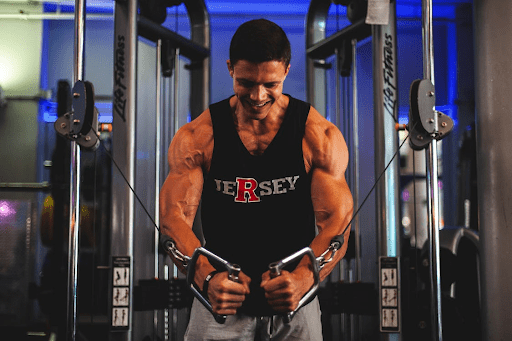

Are you looking for a different way to build muscle, increase strength, and achieve a sculpted physique while keeping your fitness routine in one place?
Cable exercises are versatile and effective ways to transform your body using a cable machine. These dynamic workouts are good for building strength, muscle definition, and enhancing flexibility.
You may be wondering are the best cable machine workouts to incorporate into my fitness routine?
This article unveils the nine best cable exercises that can help you transform your body as a bodybuilder or fitness enthusiast.
What is a Cable Machine?
A cable machine is a fitness equipment found in almost all gyms. It comprises a sturdy frame with one or more adjustable cable pulley systems, making it an effective equipment to train various muscle groups.
These machines are designed for strength training and resistance exercises.
Benefits of Cable Workouts
Cable workouts offer many benefits, making them popular for overall fitness. Here are five advantages of incorporating cable exercises into your fitness routine.
1. Reduced Weight Imbalance
Most beginners experience weight imbalance with free weights because they place direct loads on the body, which beginners find challenging to support due to lack of stability. This results in weight imbalance and inconsistent tension on muscles, leading to poor muscle development and ineffective workouts.
Unlike free weights, the cable machine loads have no direct contact with your body, reducing weight imbalance.
Cable exercises also maintain constant tension on the muscle throughout the range of motion, leading to better muscle development and effective workouts.
2. Reduced Risk of Injury
Cable machines often come with safety features such as adjustable weights and safety pins, reducing the risk of injury when training in the gym.
The cable machine provides a controlled range of motion, and cable workouts do not allow direct load on the body. You support the weight using the handles.
The cable workouts are also gentle, making them suitable for individuals with injuries and people with varying fitness levels. A study on hospital visits in the US found that free weights were more likely to cause injuries than machines.
3. Suitable for All Fitness Levels
Cable machine workouts suit all fitness-level enthusiasts. It offers adjustable resistance levels, allowing bodybuilders of different fitness levels to use them. You can gradually increase the weight as you become stronger.
Cable machines are versatile, with a pulley system that allows you to pull or push in any direction. This lets you include various workouts such as curls, overhead presses, and cable flyers into your workout routine.
4. Greater Hypertrophy and Strength Gains
Cable workouts provide more time under tension. Time under tension is the time muscles spend under stress during an exercise.
Hypertrophy and strength gain are directly linked to the tension you place on the muscle during a workout. The more the muscles stay under stress, the more they adapt to it by gaining strength and muscles.
Cable machine exercises exert stress against your muscles when working out, forcing them to contract. Since cable exercise involves working out without a break, your muscles stay under tension for longer. This makes the muscles fatigue faster, leading to faster gains in strength and muscles.

9 Cable Workouts for Effective Muscle Gains
Below are the top nine cable workouts you should consider including in your training routine.
1. Cable CrossOver
Cable crossover is one of the best double cable pulley workouts for building strength and muscle definition. It primarily targets the upper body muscles, like the triceps, anterior deltoid, and chest muscles.
How To Do Cable Crossover
Adjust the pulleys on the cable machine by setting them to the highest hole slightly above your shoulder.
Stand at the center of the cable machine with your feet shoulder-width apart.
With palms facing down, grab the pulley handles in each hand and step forward with one foot. Keep your arms outstretched to the sides, parallel to the ground, and core tight.
Pull the cable handles downwards across your body so your wrist forms an x at your chest. As you pull the handles, squeeze your chest muscles.
Inhale and slowly return to the starting position by opening your arms.
2. Cable Shrugs
Cable shrugs are effective for targeting the trapezius muscles. It helps strengthen and develop the upper part of your trapezius muscles, which are responsible for elevating and retracting your shoulders.
How To Do Cable Shrug
Set up a cable machine with a low pulley attachment and stand facing the cable machine with your feet shoulder-width apart.
Grasp the handle in each hand using an overhand grip (palms facing your body) and step back. Space your hands slightly wider than shoulder-width apart.
With your core tight and straight back, lift your shoulder as high as possible, keeping your arms extended.
Pause briefly and squeeze your trapezius muscles to maximize the contraction.
Slowly lower back to the starting position.
3. Lat Pulldown
Lat pulldown is a staple workout in most cable full-body exercises that strengthen the lat muscles. The activity allows you to use various grip positions and widths to target specific muscles in the back and arms.
How To Do Lat Pulldown
Sit on the lat pulldown machine and adjust the thigh pad to fit snugly over your thighs to secure your lower body. Your knees should be at a 90-degree angle.
Reach up and grab the bar with a wide overhand grip. Your palms should face away from your body.
Hinge back slightly, tighten your core, and pull the bar towards your upper chest or the base of your neck. Ensure you squeeze your shoulder blades together to engage your lats fully.
Hold this position briefly to maximize muscle activation before releasing the bar to return to the starting position.
Keep your movements controlled, and avoid letting the weight stack slam down.
4. Cable Lateral Raise
The cable lateral raise primarily targets the shoulder muscles, specifically the lateral or side deltoids. It’s an excellent isolation exercise for building shoulder width and creating well-defined shoulders.
How To Do Cable Lateral Raise
Adjust the cable machine to the lowest position and attach a D-handle or stirrup handle to the cable.
Stand facing the cable machine with your feet shoulder-width apart and grab the handle with your right hand, holding the cable handle with an overhand grip.
Step away from the machine so there’s tension on the cable when your arm is down by your side.
Slowly lift your right arm straight to the side, keeping it parallel to the ground. Your hand should remain at or slightly below shoulder level. Use the lateral deltoid to raise the weight.
Pause briefly, squeezing your lateral deltoid before lowering your arm to your side to return to the starting position.
5. Cable Pec Fly
Cable pec fly, or cable chest flys, is a resistance exercise primarily targeting the pectoralis major muscles. It also engages the anterior deltoids (front shoulder muscles) and the triceps to a lesser extent.
Cable pec fly is effective for building chest strength and enhancing muscle definition. However, it requires higher stability.
How To Do Cable Pec Fly
Adjust the pulleys on the cable machine to their highest position to target your lower chest, lower to target the upper chest, and middle to target your mid pecs.
Stand in the middle of the cable machine and grasp one handle in each hand. Take a step forward with one foot to slightly lean forward. Maintain a straight back and tighten your core muscles.
Extend your arms straight in front of you, palms facing up, and bring them together in a controlled and deliberate motion so that the cable’s pull line is roughly parallel to your armpit.
Squeeze your pec muscles and hold this position for a moment to maximize muscle engagement.
Slowly return your arms to the starting position and repeat before switching to the other feet.
6. Cable Face Pull
Cable face pull is a popular workout in the warm-up routine of the upper body exercise. It primarily targets the upper back and shoulder muscles, such as the rear deltoids, traps, and upper trapezius muscles.
Face pull is an excellent exercise for improving posture, strengthening the upper back, and enhancing shoulder health.
How To Do Cable Face Pull
Adjust the pulley to a height above your head and clip in a D handle or rope attachment.
While facing the cable machine, grasp the ropes with a neutral grip and hands positioned slightly wider than shoulder-width apart.
Take a step or two back from the machine to create tension in the cable stack.
Slightly bend your knees and pull the ropes towards your face while keeping your elbows high and out to the sides. Squeeze shoulder blades together as you pull.
Pull the ends of the ropes to your face so that they pass the sides of your face or slightly touch it. Squeeze your shoulder blades for a moment.
Slowly extend your arms to return the ropes to the starting position.
Although a band can be used on the face pull workout, the cable stack is more beneficial. The cable stack provides constant tension that targets small muscles overwhelmed by elastic stress from bands.
7. Cable Curls
Cable curls are an excellent workout to train biceps muscles. It helps develop strength and definition in the biceps, making it a popular choice for individuals looking to build their arm muscles.
How To Do Cable Curls
Stand facing the cable machine with your feet shoulder-width apart and grab the bar with your palms facing inward.
Flex your elbows and curl the bar upward toward your shoulders. Keep your upper arms stationary throughout the movement; only your forearms should be moving.
Curl until your biceps are fully contracted.
Pause and squeeze your biceps before slowly lowering the bar back down to the starting position.
8. Cable Lunges
Cable lunges are a variation of the traditional lunge exercise that targets the lower body muscles, particularly the quadriceps, hamstrings, glutes, and calves.
How To Do Cable Lunges
Attach a handle to the low pulley of a cable machine and stand with your right foot in front of the other, holding the handle with both hands.
Lunge down toward the floor and tighten your core. Ensure that your front knee stays in line with your ankle and your back knee doesn’t touch the ground.
Stand back up and return to the starting position.
9. Seated Cable Row
Seated cable rows provide multiple hand grips and elbow positions to target various back muscles.
How To Do Seated Cable Row
Sit on the cable row machine’s bench with your feet hip to shoulder width apart on the machine pad.
Grab the handle attachment with both hands, palms facing down.
Hinge from your hips, but ensure your lower back remains straight.
Tighten your core and pull the cable handle towards your torso by retracting your shoulder blades and bending at the elbow. Continue pulling until the handle touches or nearly touches your lower rib cage.
Pause briefly at the fully contracted position, feeling the squeeze in your shoulder muscles. Slowly extend your arms back to the starting position.
Conclusion
Cable exercises offer a dynamic and versatile approach to fitness that can’t be ignored. From sculpting a chiseled physique to enhancing functional strength, the benefits are boundless.
Incorporate these nine cable exercises into your fitness regimen today and experience remarkable results! Start sculpting, strengthening, and achieving your fitness goals like never before.






















You must be logged in to post a comment Login